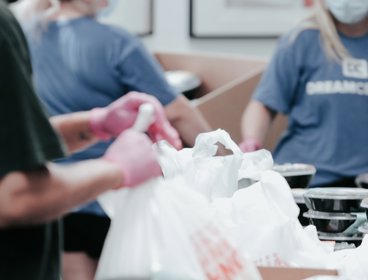By Cheryl McGeachan, University of Glasgow
Experiences of mental ill-health can be challenging to communicate but they are an inherently important aspect of our human condition. Understanding the varied lived experiences of mental ill-health is of vital importance for geographers, opening up ways to share how worlds are changed, altered, obliterated and transformed by such conditions and processes.
Understanding the lived worlds of mental ill-health requires engaging with a wide variety of stories, sources and experiences. Our project has used an art collection, called Art Extraordinary, to explore the lived worlds and experiences of mental ill-health from a variety of perspectives. Art Extraordinary is a unique collection of Scottish “outsider art” collected by Joyce Laing, a pioneering art therapist and advocate for the arts and mental health. Most of the artists who feature in this collection are individuals who had no formal art training, were marginalised, and whose mental health was cared for in and out of institutional settings. Joyce, from the 1970s, spent over forty years collecting pieces of work from the Scottish mental health landscape, scouring in rubbish bins, gardens and hospital wards, and amassing a collection of over 1000 pieces. The collection was donated to Glasgow Museums by Joyce in 2012 and represents lives and experiences largely unknown and neglected in our contemporary society.
Since 2012 we have worked in partnership to explore the Art Extraordinary collection and to tell new stories about the worlds of mental ill-health from a historical and contemporary perspective. From the outset, myself as a human geographer interested in the lived experiences of mental ill-health, has partnered with Scottish History Curator, Dr Tony Lewis, and Open Museum Curator, Claire Coia, to develop a shared platform from which we can develop work with Art Extraordinary. Our first step was to consider how the collection could be used to incite new ways of understanding art and mental health. We decided that in order to interpret and story the collection in a meaningful, informed and ethical way, we needed to work with experts: people with lived experience of mental ill-health and healthcare providers.
This partnership has inspired over a decade of collaboration with a range of dynamic organisations and passionate individuals with lived experience of mental ill-health. These include Leverndale Recreational Therapy Unit, Barlinnie Prison, Project Ability and Gartnavel Hospital. Our various projects have taken the Art Extraordinary objects beyond the walls of the museum and into different community and institutional spaces. We have co-run art-making and storytelling workshops, developed multiple exhibitions, including the first permanent community curated exhibition on mental ill-health in Glasgow’s flagship museum, Kelvingrove, undertaken museum store tours, written poetry and songs, and undertaken pioneering research into the collection.
The key to the success of this project is collaboration and listening to the voices of experience that are embedded deeply within diverse community spaces. For example, we worked with people in HMP Barlinnie to curate our first Art Extraordinary handling kit – a community resource of museum objects that can be borrowed and used by publics. Each group learned basic curatorial and research skills, from object handling and preventive conservation, to archival research and writing exhibition text. From the process, we gained new insights into the artworks and their stories of experience. All of our projects place communities at the centre, drawing upon and valuing their knowledges, ideas and skills. Every item for every exhibition has been carefully selected by communities and exhibition texts written by communities for communities. Community voices are centralised and become the driving force for future collaborative pathways.
Our ethos for collaboration is deeply embedded within working with communities and individuals to explore the Art Extraordinary collection. Undertaking such work requires an ability to engage collaboratively and openly with individuals, groups and organisations. It is an emotional and affective undertaking. The worlds of mental ill-health can be difficult to navigate and take time and trust to access. Working in partnership, particularly with experts by experience, requires commitment that stretches beyond traditional academic partnerships. Yet, anyone can apply it. Finding partnerships that work for both your area of interest and your own personality is key. To truly work alongside people you have to be authentic, committed and open, and these provide the foundations for any community projects.
Summary
-
Working collaboratively with museum collections allows the lived worlds and experiences of mental ill-health to be explored from a variety of perspectives.
-
Centralising community voices and experiences can drive innovative research.
-
Meaningful collaboration requires trust, commitment and authenticity to succeed.
How to cite
McGeachan, C. (2023) Mental ill-health geographies and the arts. Working with voluntary and community groups. Royal Geographical Society (with IBG) Guide. Available at: https://doi.org/10.55203/EIDV9730
About this guide
Working with voluntary and community organisations for some is a very important way to do geography. These organisation come in various shapes and sizes and may also often be referred to as the third sector, the voluntary sector, not-for-profit organisations, community groups or the civic sector. In this guide, we share the experiences of researchers doing geography in collaboration with community and voluntary organisations. A range of topics and issues are explored from health, disability and care, through to austerity, violence, and craft, amongst others. We learn about the approaches taken by geographers in their work with community and voluntary organisations, and some of the challenges they have negotiated in the process.




